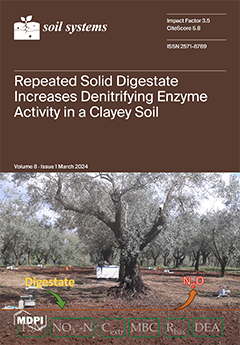Irrigation of calcareous soil with saline–sodic water can modify the composition of the soil solution and exchange complexes in agricultural land of arid and semi-arid regions with low water resources. The objective of this study was to monitor (medium-term) potential changes in a calcareous clay soil irrigated with two types of sodic waters without cropping. Irrigation water with two high sodium adsorption ratios (SAR = 20 and 40) and electrical conductivity (EC < 3 dS m
−1) was prepared using NaCl and NaHCO
3 salts. The sodic irrigation waters were applied (June–October) in three periods (1, 2, and 4; one period = five irrigations) to bare non-saline soil with drip irrigation during two growing seasons; no irrigation action was taken in the winter–spring rainy season (period 3). Sampling (0–30 cm) was made after each period to determine the changes in soil pH, EC, water-soluble Na
+, Ca
2+, Mg
2+, K
+, Cl
−, and HCO
3−. Relative to the control, irrigation with both sodic waters increased soil pH, EC, and water-soluble Na
+ and decreased or did not change water-soluble cations (Ca
2+, Mg
2+). The Cl
− concentration increased rapidly with NaCl-type water application, but it was leached away quickly by winter–spring rains. The HCO
3− concentration increased with NaHCO
3-type water application, yet it leached out slowly in the rainy period. The movement of HCO
3− ions in the upper soil profile (0–30 cm) was significantly slower compared to Cl
− ions. Dissolution of slightly soluble soil CaCO
3 by irrigation increased the solution concentration of Ca
2+ and its mobility, yet the kinetics of processes depended on water type and irrigation period. The released Ca
2+ interacted with other cations in the soil, causing further significant positive physicochemical changes in the soil solution and exchange capacity (comparable with control soil) at the end of the irrigation period. The CaCO
3 content in the soil would be a long-term guarantee of the Ca
2+ resource in soils, even if the amount of water-soluble Ca
2+ may decrease for the short-term period during irrigation. The results should be considered for rational irrigation management (with various water qualities) in semi-arid and arid regions.
Full article





